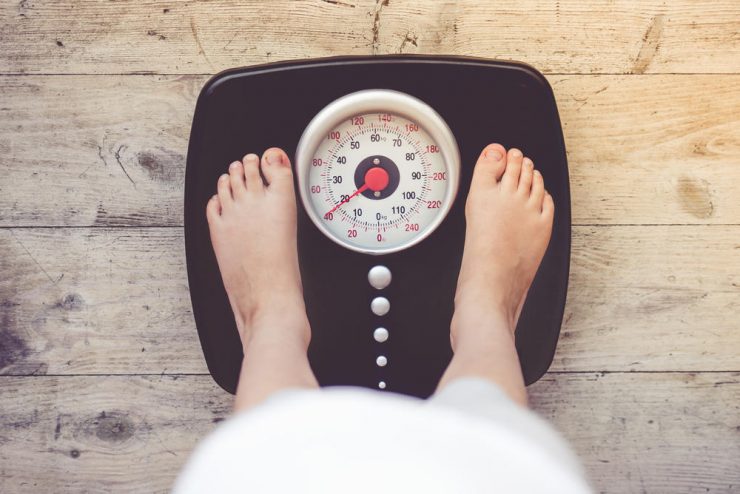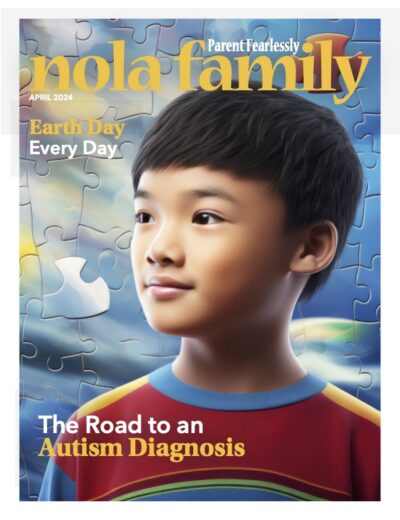
Heavyset: one NOLA teen’s journey.
By Mary Murphy

There hasn’t been a point in my life where I haven’t been at least thirty pounds over the healthy limit. I definitely have more stomach than I’m comfortable admitting. It was most noticeable when I had to wear school uniforms, especially in elementary school. Girls could only wear white button-up blouses, blue plaid skirts, and all-white shoes. My blouses started in mediums instead of smalls. My skirts always found ways to dig into my stomach, and plaid has never been a good pattern on me. My shoe size was the only thing that mirrored other girls, but they don’t take pictures of your feet for the yearbook. They take it from the waist up, and from the waist up, I was a helium balloon.
There’s this one photo of my high school freshman Humanities class taken in secret while we were working on a project. I appear in the front corner, hunched over my desk to read the book that was assigned. My back is facing the camera, so you can’t see my face, but you can still point me out. The black jacket I wear highlights the fact that I’m the widest person in the room. It used to be a part of a photo montage that played on the TVs outside of school. I always stopped whatever I was doing when it popped up and stared at myself. I looked more like a stone column than a human being.
Weight Watchers was my mom’s idea. It first came up when she proposed a girls’ day out. We drove down to Magazine Street and planned to stay there for two to three hours. We only went to two stores.
One of the stores was Buffalo Exchange. The best way I could describe it is if Goodwill went grunge. Alternative songs dimly played over the loudspeakers. It smelled like someone threw musky cologne on all the clothes. My stomach automatically sucked in as we went inside.
Buffalo Exchange generally caters towards people who like wearing tight-fitting, short clothing. Out of the eight items I found, only one thing fit: an “L” maroon cotton dress. I had to keep pulling it down so it could reach the midway point of my thigh. I could tell the dress wasn’t made for me. For a second opinion, I went outside the dressing room to where Mom was standing. She scanned me up and down.
“I like it,” she said. “Do you like it?”
“Yeah, I like it.” I glanced back at the mirror in the corner of the dressing room. “It looks nice.”
“That’s good.” She slightly tilted her head. “It’d be a really cute top. It would go great with your black leggings.”
“But it’s a dress.”
“It’s a little too short, though. I think it would last longer as a shirt than a dress.”
I’m not sure what set me off, but I barely made it outside the store before I started crying. We got back into our car and began driving home. “I know it’s frustrating, baby.” Mom spoke when the crying momentarily stopped. “We can start a diet. We can do Weight Watchers, if you want.”
I took a few deep breaths. Weight troubles weren’t a foreign concept to my family. Mom has always begrudged her pear figure and Dad’s stomach has been as puffed up as a pillow for as long as I’ve known him. We’ve tried exercising more regularly, cutting down salt in meals, getting rid of soda drinking altogether. Nothing stuck. We’ve always reverted back to old habits. A diet wouldn’t change much.
“I’d like that, yeah,” I answered.
I saw Mom look at me from out of the corner of my eye. “Yeah? You wanna do it? Dad can get on it, too.”
“Yeah,” I turned on the radio, “let’s do Weight Watchers.”
Walking inside Weight Watchers felt like going to an AA meeting. The air felt sterile, almost purposefully bland to help people work through their issues. Right next to the huge glass windows was an old brown wooden desk, run by two white women. A candy-colored assortment of pamphlets rested against the wall. In front of the desks sat the real reason any of us were there: two silver electronic scales.
There are three books you get when you sign up for Weight Watchers: a paperback book with a tacky plastic cover welcoming you to the program and telling you in excruciating detail what you’ve just gotten yourself into; a smaller, but equally tacky, plastic-covered paperback that lists every “point” associated with every menu item at every fast food chain in America (it was supposed to help you keep on track for weight loss, but I found looking inside just made me depressed); and a pamphlet, barely larger than my hand, called “My Success Story.”
At Weight Watchers, you need to set a specific goal for weight loss. It can be something as simple as five pounds or as drastic as fifty. The key to it all was “My Success Story,” where you learned how close you were to being skinny and fancy-free. At the beginning of every meeting, the ladies behind the desk take your weight on the electronic scales, print out the results on a sticker, and stick it into your booklet. At the first meeting you attend, they have to take a preliminary reading. I did mine first.
“Y’know,” one of the women behind the counter, the curly brunette, said, “it’s a tradition among participants to take their shoes and socks off before stepping on the scale.” She flashed us a small, knowing smile. “They think it gives them the most accurate weight.”
“Does it?” I asked.
“No,” the other woman behind the counter, the silver-haired one, answered. “It might take off a gram, but nothing significant. These are the most accurate scales money can buy.”
Weighing one gram less seemed good to me, though, so I took off my shoes and socks anyway.
By the time I had stepped off and put my shoes back on my feet, my “Success Story” booklet was on the counter and Mom was getting her reading done. I picked up my book and opened it to see my results.
Two hundred and fifteen pounds.
It stung. I figured I was around that weight, as I’d had a similar one recorded during a doctor’s physical, but it still stung to see I really was that fat. However, I figured everyone who did Weight Watchers had a lead ball sitting in their stomach when they did their first reading. I’d just have to wait until the number dropped.
Mom finished her reading and we walked to the back room. Only a handful of people showed up. Most of them were like Mom and I, sick of looking awkward in clothing and only mildly chubby. In the middle of a room with plastic rainbow-colored chairs, there was a woman with curly brown hair who had lost fifty-five pounds on Weight Watchers. Fifty-five! It was unheard of! She introduced herself as our mentor.
“Raise your hand if you lost weight this week,” our mentor said.
Five people raised their hands.
“Now, raise your hand if you gained weight this week. Don’t worry, we won’t judge you.”
Three people raised their hands. Mom and I kept our hands down for the time being.
“What did you do differently this week?”
One of the latter hands, a tanned woman, spoke after a small silence. “It was my husband’s birthday. We ate lobster and I just lost control.”
“That’s okay,” our mentor reassured, “but you need to control your portions. Lobster is a very fatty meat, and it’s worth a lot of points, so eat carefully.”
The tanned woman nodded her head.
After fifteen minutes of inspirational quotes occasionally interspersed with fat-shaming comments, our mentor ended the meeting by creating a challenge. She turned to her large paper board and wrote down in large, scrawling handwriting, “LOSE 10 POUNDS” in the next two weeks.
“Wouldn’t it be nice to be ten pounds lighter by next month?” Our mentor underlined what she wrote and held out the marker towards the crowd. “I want you to sign it!”
Ten people signed on to the challenge, with two of them being my Mom and I.
In Weight Watchers, each food has a certain number attached to it called a “point.” These points were created based off the fat content and overall health value of that food. We were only allowed so many points in the day, so we had to closely track and spend them. A sugary can of Coca-Cola takes away eight of your precious points. However, grapes — fruit in general, really — cost nothing because of their lack of fat content. We could eat as many grapes as we wanted without consequence. Imagine all the points we’d save. Imagine what we could use them for instead.
We had to fill out a tiny green booklet each day known as our “Point Tracker.” There we wrote down everything we ate, added up all the points, and saw how we did. I was allotted thirty-eight points because I was still a minor and still growing. After a few weeks, I formulated a routine.
I had two options for breakfast in the morning. One of them was a smoothie, provided by Weight Watchers as one of their many tie-in products. That was either two or five points, depending on whether or not I added milk. Despite using a blender, the powder didn’t always mix properly, and the chocolate flavoring I selected tasted chalky. It might have been better if I just ate the powder raw. The other option was eating nothing at all and pocketing the points. More often than not, I skipped breakfast.
Lunch got a little more complicated. I could only use Arnold’s 100% Whole Grain Sandwich Thins (two points) for sandwiches. The middle part was filled with a handful of ham carefully measured out the night before (also two points), a single slice of low-fat American cheese (one point), and a teaspoon of Hellman’s mayonnaise (three points). I also included generic, sometimes metallic-tasting, Weight Watchers chips, which were two points, and a fruit or vegetable, which had no points. I developed an addiction for Lipton Diet Green Tea, also zero points, and to this day I’m still attached to the semi-tangy taste. For dessert, I packed another Weight Watchers product: their candy. It was the only thing they produced that I actually liked. Bite-sized chocolate caramel bars and fluffy, pink bite-sized cupcakes with sprinkles dashed on top. It tasted like actual food. The best part? Only two to three points a pop.
I never counted snacks I had in between classes. I’d usually get fruit gummies from a healthy snack cart provided by the school. It shouldn’t have mattered that the first ingredients were corn starch and sugar. Fruit was always free, right?
On the car ride home from school, I would brace myself and ask what was for dinner. It didn’t matter if we were having smooth Southern red beans and rice or oddly textured wheat pasta and meatballs, dinner was always a hard hitter.
A part of me really wanted to keep loyal to Weight Watchers and finally lose weight — I hated how I looked then, and I still hate how I look now. The other part of me, though, loathed dieting and loathed Weight Watchers. I hated not being able to eat and drink things I really enjoyed. I hated those awful chocolate smoothies.
However, I decided not to bring up the topic with my parents until their three-month subscription ended. Weight Watchers thinned out our wallets much more effectively than our waistlines. Tie-in snacks, licensed scales, weekly renewals of my “still a minor” subscription so I could attend meetings; all of it added up to a hefty fee. My parents told me from the start that money wasn’t an issue to them, but it was always an issue to me. I didn’t want them feeling like they got ripped off.
Despite my feelings, the program did work. Every time I had to step on the electronic scales, the sticker that printed out was always a little lower. Within the first week I lost a pound. The week after, that two pounds. Seeing the ticket each week almost made all the suffering worth it. I lost seven pounds overall. I’ve gained it all back, but for a time, Weight Watchers worked. I just hated doing it.
As it turns out, my parents hated it, too. Dad was the first one to drop the program. A week or so later, during a car ride home from school, Mom followed suit.
“Would you be okay with stopping Weight Watchers?”
I wanted to cry in relief. “Yeah, I’d be okay with that.” I glanced at her. “Didn’t you sign up for three months though?”
“Oh, no, that was only a month,” she explained. I didn’t believe her, but I think she was as fed up with Weight Watchers as the rest of us at that point. “We know the program by now, anyway. We’ll just buy a scale and watch our portions.”
I nodded. Portions were always a problem.
Within two days I started ignoring portion recommendations again.

Mary Murphy is a seventeen-year-old senior at NOCCA. She now walks for weight loss instead of doing Weight Watchers — it makes her feel a lot better.

